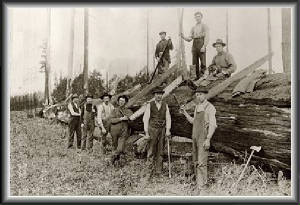
The center for Norwegian immigrants was
in the Midwest. Many
settlers often arrived and lived in various locations in the US,
but the majority settled permanently in the Midwest, and especially Minnesota.
In the beginning of the immigration period, the most settled states were Minnesota, South Dakota, North Dakota, Wisconsin,
Illinois, Kansas, Alabama, Mississippi and Florida. However, due to gold rush and other reasons, states like California,
Washington, Oregon, Montana,
Texas and Alaska had all thousands
of Norwegians settlers. As an additional fact, by 1920, every 20th inhabitant of Seattle
had either been born in Norway, or was born on America of
Norwegian parents. However, in the 20th century and especially into the 1920’s, the settlement to farm land
in the Midwest decreased in favor of moving to big, and growing, cities like New York, Chicago, Seattle, San Francisco, Minneapolis
and Los Angeles. As World War 1 had its end and as citizens and immigrants said hello to the flowering 1920’s, the times
had changed significantly. Most Norwegian immigrants, also those who went in the hope of getting a big farm in the Midwest,
ended up working hard in factories in cities throughout the whole US. The hard work at factories didn’t give enough
money to raise a family and live the good life, so about 40% of all immigrants from Norway
during this period of time went home shortly due hard work, poverty and homesickness. Many also planned to make some money
in America and then return back to Norway,
but the majority had to, as mentioned, go back home as even poorer as they came.
However, though small and cold was a far away from the immigrants new life in America, the majority of Norwegians
lived as close to Norwegian culture as they could. Own newspapers, such as “Skandinaven” was published. Christmas
was celebrated the Scandinavian way and May 17th, the national day of Norway,
was of course a big day with great celebrations. Also the Norwegian language
was taking care of in the many Norwegian societies throughout the whole country, and the many dialects that the language has
was cleaner than it in many cases would have been back in Norway. It is often jokingly said that Norwegians are “born
on skis”. Skiing has since it was “invented” been a favorite activity for most Norwegians, and those who
immigrated to the US brought their skills and interest with
them. Organized skiing competitions began in the early 1920’s, and the Seattle Ski Club, whose members were all first
generation Norwegians, was established in 1928 for the purpose of promoting the spirit of skiing to both immigrants and Americans.
However, when the Stock Market crash occurred in 1929 followed by the Great Depression, the great immigration from Norway,
as well as from other countries, stopped immediately
All in all, as a conclusion, I will say that the Norwegian culture,
due the great immigration, has its part in the American culture. The heritage from the thousands of people that decided to
leave Norway has influenced, especially the Midwest, a lot, and it always
will. The great immigration has given the two respective nations and its people a unique friendship. I think it is important
that today’s and tomorrow’s Norwegians remember the opportunity and help America and its people gave our ancestors.
This is especially important today, since the last generation of immigrants and their kids soon will be gone. It is also important
in the age we are living in, where good relationship among countries no longer can be taken for granted, but is a key for
a better world, that everyday-people in different countries can have a good relation to each other though governments and
administrations might not cooperate as much as we wish due various reasons. I think that we in memory of the immigrants, who
lived and melted cultures together, can make a better and peaceful world based on respect.

HHS
AP US History 2005
|

